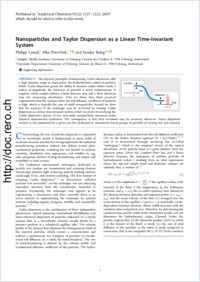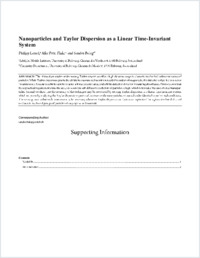Nanoparticles and Taylor dispersion as a linear time-invariant system
- Lemal, Philipp Adolphe Merkle Institute, University of Fribourg, Switzerland
- Petri-Fink, Alke Adolphe Merkle Institute, University of Fribourg, Switzerland - Chemistry Department, University of Fribourg, Switzerland
- Balog, Sandor Adolphe Merkle Institute, University of Fribourg, Switzerland
-
15.01.2019
Published in:
- Analytical Chemistry. - 2019, vol. 91, no. 2, p. 1217–1221
English
The physical principles underpinning Taylor dispersion offer a high dynamic range to characterize the hydrodynamic radius of particles. While Taylor dispersion grants the ability to measure radius within nearly 5 orders of magnitude, the detection of particles is never instantaneous. It requires a finite sample volume, a finite detector area, and a finite detection time for measuring absorbance. First we show that these practical requirements bias the analysis when the self-diffusion coefficient of particles is high, which is typically the case of small nanoparticles. Second we show that the accuracy of the technique may be recovered by treating Taylor dispersion as a linear time- invariant system, which we prove by analyzing the Taylor dispersion spectra of two iron-oxide nanoparticles measured under identical experimental conditions. The consequence is that such treatment may be necessary whenever Taylor dispersion analysis is not optimized for a given size but dedicated to characterize broad groups of particles of varying size and material.
- Faculty
- Faculté des sciences et de médecine
- Department
- Département de Chimie, AMI - Bio-Nanomatériaux
- Language
-
- English
- Classification
- Chemistry
- License
- License undefined
- Identifiers
-
- RERO DOC 324102
- DOI 10.1021/acs.analchem.8b04228
- Persistent URL
- https://folia.unifr.ch/unifr/documents/307507
Other files
Statistics
Document views: 72
File downloads:
- fin_ntd.pdf: 166
- fin_ntd_sm.pdf: 90

